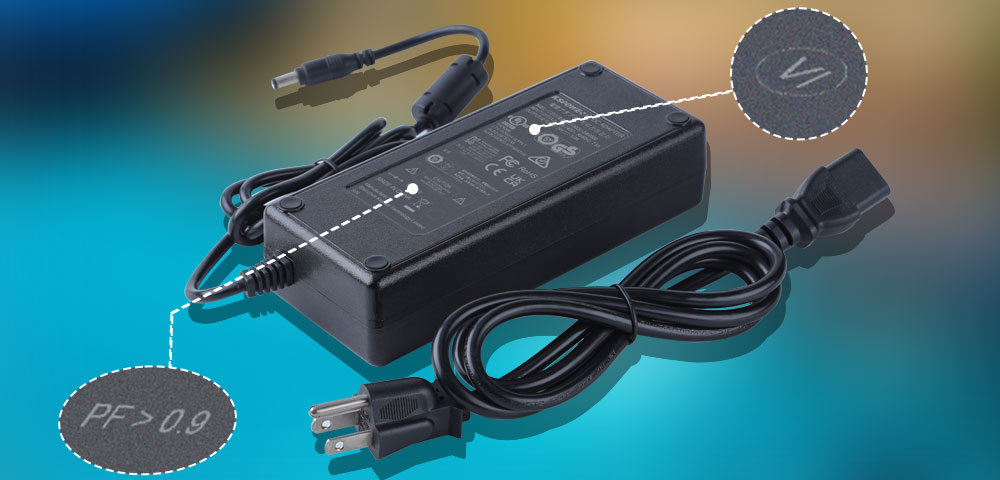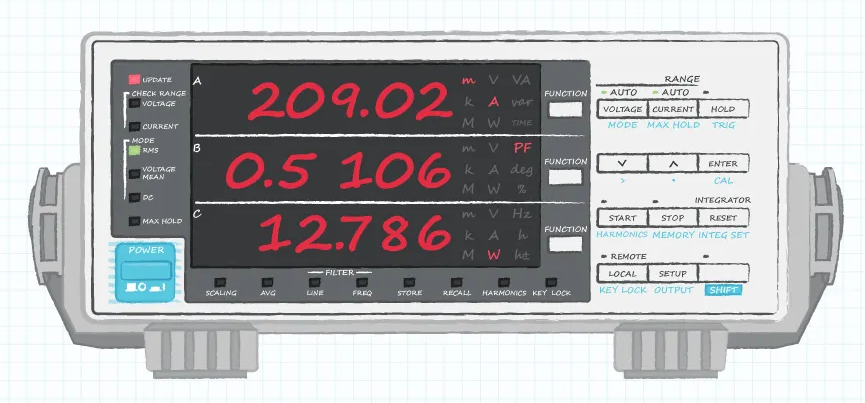
Basics of Power Factor and Efficiency
Engineers working with external power supplies (EPS) are no stranger to efficiency measurements. However, since their applications typically operate on DC power supplies, common mistakes can be made when measuring power on the AC side of the power supply. These common pitfalls include incorrectly measuring or completely ignoring power factor when calculating power input power, resulting in incorrect efficiency measurements. Let's review the basics of power factor and efficiency and then provide guidance on how to include power factor when measuring AC. DC power efficiency.
Power Factor and Efficiency, a Review
Efficiency (η) is the ratio of output power to input power:

Equation 1: Efficiency
In the context of an External Power Supply (EPS) dealing with direct current, the output power is calculated by simply multiplying the output voltage by the output current by quickly providing the numerator to equation.
Calculating Output Power
Calculating the output power of an EPS, which is dc, is simply the output voltage multiplied by the output current:

Equation 2: Output Power
Equation 2 calculates the direct current (dc) output power (P_dc) of an Electric Power Supply (EPS) by multiplying the output voltage (V_dc) by the output current (I_dc), resulting in the power measured in watts (W).
Understanding Power Factor
A common mistake is to apply this same calculation to obtain the input power. This presents a problem because the volt-ampere product in ac circuits does not always equal the real power, and in fact, in the case of external adapters, the volt-ampere product will never equal the real power. In ac circuits, the volt-ampere product is equal to the apparent power (S), which is related to the real pow-er through a term called Power Factor (PF):

Equation 3: Apparent Power
Equation 3 computes the apparent power (S) in volt-amperes (VA) by multiplying the root mean square (rms) voltage (Vrms) with the rms current (Irms).
Defining Power Factor
By definition, power factor is the ratio of real power to apparent power, where apparent power is the product of the rms voltage and rms current. Only when the power factor equals 1 does the volt-ampere product equal the real power:

Equation 4: Power Factor
Measuring Power Factor
The best way to measure power factor is to use a power meter like the one shown in Figure 1 below. These devices will output the real power directly, so power factor does not need to be considered when calculating efficiency. In addition to the real power, these meters can measure power factor, THD, the current for each harmonic, and more. While low power external adapters do not have de-fined power factor or harmonic limits, higher power supplies do have specific regulatory limits on the harmonic content and power factor. Standards, such as EN 61000-3-2 specify limits on harmonic current up to and including the 39th harmonic, for certain power levels. When measuring the harmonic current of a power supply, a power meter is essential.

Figure 1: WT210 Power Meter showing measurements corresponding to waveforms
Power Factor in Power Supplies
You may think that the impact of omitting the power factor will result in only a slight error and/or that the power factor of an external adapter cannot be that bad. In fact, without power factor correction, the power factor of an external adapter could easily be as low as 0.5 at a rated load. An adapter with a power factor of 0.5 will have an apparent power twice that of the real power, thus leading to incorrect results. Even if the power supply had a real efficiency of 100%, this measurement would only show 50%.
In addition to the general inclusion of power factor in efficiency calculations, it is important to note that the power factor is line and load dependent. Efficiency requirements, such as DoE Level VI, require the efficiency to be measured at several points (25%, 50%, 75%, and 100% load) at both high and low line voltages. If power factor is used in the calculation of real power, then it must be re-measured for each of these conditions.
Power Meters for Accurate Efficiency Testing
Decades of increasing regulation have made efficiency testing one of the most important factors in selecting and qualifying power supplies. Lack of experience in dealing with ac circuits can lead test engineers to omit or to incorrectly calculate the power factor, resulting in incorrect efficiency numbers. When testing external adapters, or any ac-dc power supply, the best method for calculating the real power input is through the use of a power meter. These devices not only measure real power directly but can measure the current associated with the individual harmonics and provide a complete picture of the power supply input.
Power factor is on the list of concerns for designers of virtually every device that draws significant power from a mains socket, as well as for engineers in heavy-electrical sectors. The power factor target, based on legislation, plus efficiency, component cost, and volume/board space need to be considered.
KSPOWER has designed active power factor correction into the vast majority of its ac-dc power supplies rated at 105 W and above to help ease implementation and ensure compliance for OEMs.